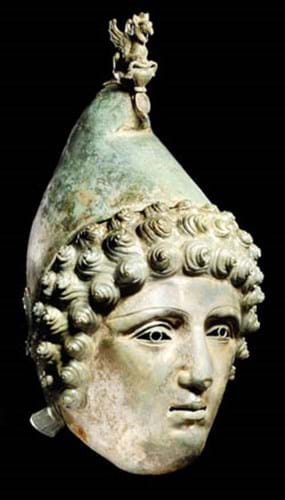
The financial value of his discovery will be decided on October 7 when it comes up for auction at Christie's South Kensington on with an estimate of £200,000-300,000.
The Crosby Garrett helmet, named after the small village to the west of Kirkby Stephen in Cumbria where it was found, is a rare full-face version of a type used during hippika gymnasia (cavalry sports events) designed to show the might of the Roman army.
Just two others have been discovered in Britain: the Ribchester helmet, found in 1796 and now in the British Museum, and the Newstead helmet, found in 1905, housed in the Museum of Antiquities in Edinburgh. The griffin surmount is previously unrecorded.
The remarkably short time between discovery and sale is explained by the terms of the 1996 Treasure Act. Under the law, treasure hunters who find objects that are at least 10 per cent gold or silver and more than 300 years old are legally obliged to inform the local coroner within 14 days to allow for an inquest to determine whether or not they are the legal property of the finder/landowner or the crown.
However, in this case no inquest was required as the Crosby Garrett helmet was not part of a larger hoard and is made of bronze. The sale proceeds will be split between the finder and the landowner.
The Tullie House Museum and Art Gallery in Carlisle has launched an eleventh hour public appeal to acquire what they hope would be the centrepiece of the new £1.5m 'Roman Frontier: Stories Beyond Hadrian's Wall Gallery', due to open at the Museum during summer 2011.
Carlisle - then called Luguvalium - was one of the most important cities in Roman Britain and the administrative centre for Hadrian's Wall.
• Meanwhile, on September 30, London numismatists Spink will offer for sale an Iron Age gold torc recently found in the Diss area of Norfolk.
Immediately identified when brought to the valuation desk earlier this year, after completion of the treasure review process it was returned to the owner together with an approximate dating of 150 to 50BC.
Torcs were symbols of high social standing in the Iron Age and probably awarded to great warriors as a way of commemorating their fearlessness on the battlefield.
It is very similar to others in the famous Snettisham hoard in the British Museum and the first time in many decades that a gold torc from the British Iron age has been available on the open market. The estimate is £25,000-35,000.




